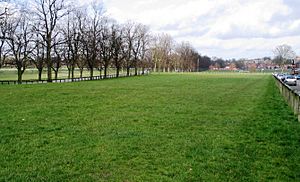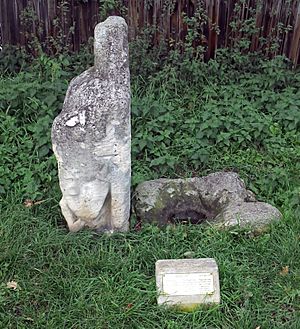Strays of York facts for kids
The Strays of York are four big open areas of land in the city of York. Together, they cover more than 800 acres (about 3.2 square kilometers)! Their names are Bootham Stray, Micklegate Stray (which includes the Knavesmire and Hob Moor), Monk Stray, and Walmgate Stray. These areas are like big parks where people can enjoy nature and open space.
Contents
A Look Back: The History of York's Strays
For a very long time, the Strays were much larger areas of "common land." This meant that people called Freemen of York had a special right. They could let their cattle graze freely on this land. This right had been in place for hundreds of years!
In the 1700s and early 1800s, laws were passed to "enclose" common lands. This meant turning shared land into private property. But instead of losing their grazing rights completely, the Freemen were given specific areas of land. These new areas, along with the Knavesmire and Hob Moor (which the city already used for grazing), became what we now call the Strays. The city's government holds this land in trust for the Freemen of each of York's original four areas, called Wards.
Who Manages the Strays Today?
At first, each Stray was looked after by "Pasture Masters." These were people chosen by the Freemen of each Ward. They managed the land only for the Freemen living in their area.
Over time, things changed. In 1905, the City of York took over Micklegate Stray. By 1907, a new law meant the Freemen gave up their grazing rights there. In return, they received a yearly payment.
Later, in the 1940s and 1950s, the City made similar deals for the other three Strays. The Freemen agreed that the City would manage their Stray. It would be an "open space for the benefit and enjoyment of the citizens of York for all time." In exchange, the Freemen received a small yearly payment.
Today, Pasture Masters are still chosen each year by the Freemen. The City asks for their advice on big changes to how the Strays are used. If the City wants to build something on a Stray (other than things for public fun like sports pavilions or toilets), they need the Pasture Masters' permission.
Exploring Bootham Stray
Bootham Stray is located north of York city centre. You can find most of it on both sides of Wigginton Road (B1363). It stretches between the Nestlé chocolate factory and the Bumper Castle pub.
Some parts of Bootham Stray are narrow strips of land. These border Wigginton Road up to Clarence Gardens. However, many of these smaller parts have been built on. Some are now even front gardens of houses.
Discovering Micklegate Stray
Micklegate Stray is to the south-west of York city centre. It lies on both sides of Tadcaster Road (A1036). This Stray includes two very well-known areas: the Knavesmire and Hob Moor.
The Knavesmire is a large, open space that is easy to see and get to from a main road. It is home to the famous York Racecourse. A quiet, tree-lined public road called Knavesmire Road crosses the Knavesmire. It runs from a charming Herdsman's Cottage to the South Bank area of York.
South of the racecourse, a cycle path crosses the Knavesmire. This path is part of the National Cycle Network. It's a great spot for cycling and walking.
To the north-east, the Knavesmire ends at Albermarle Road. But Micklegate Stray continues closer to the City Walls. Much of this area has allotments (small plots of land for gardening). Scarcroft Park is also here. It's a nice open space with a bowling-green, and you can get to it from the City Walls.
Exploring Hob Moor
Hob Moor is a special place known as a local nature reserve. It's an open space where you might see cows grazing. It's also popular with walkers and cyclists. Sometimes, after a lot of rain, parts of it can get quite wet.
The main part of Hob Moor is west of the railway line. Two primary schools are located on the Moor. A marked cycle path crosses Hob Moor. It connects the Knavesmire to Acomb.
You can get to Hob Moor from the Knavesmire and Tadcaster Road. There's a path that goes past some allotments. On this path, you'll find Hob's Stone. This is an old stone from the 1300s, shaped like a coffin lid. It has a worn-out carving of a knight. Next to it are a flat stone and a basin. This basin was used as a "Plague Stone" in the 1600s. People would fill it with vinegar and wash their coins there. They wrongly believed this would stop the bubonic plague from spreading through money.
Hob Moor can also be reached from St Helen's Road/Thanet Road to the south. You can also get there from Green Lane and Hob Moor Drive/Holly Bank Road to the north.
Discovering Monk Stray
Monk Stray is located north-east of York. It runs along both sides of Malton Road (A1036). It stretches for about one and a half miles from Heworth Green to the Monk's Cross area.
On the west side of the Stray, you'll find the Heworth Golf Club. The eastern side, known as 'Heworth Stray,' is a lovely open parkland. This parkland offers great views of York Minster. It's sometimes used for community events, like the 2009 Tour of Britain festival.
Outside the old City boundary, the Strays on both sides of the road are less maintained. They can get boggy when it's wet, especially on the paths made by walkers.
Exploring Walmgate Stray
Walmgate Stray, also called Low Moor, is the least visible of the Strays. Unlike the others, it's not right next to a main road. It's located south-east of the city. You can get to it from Heslington Lane, Heslington Road, and University Road. You can also reach it from Fulford Road (A19) by going through allotments or using a cycle path.
The entrance from Heslington Road is between the University's Fairfax House and The Retreat. Next to it is a Herdsman's Cottage from around 1840.
From the Herdsman's Cottage, the Stray first goes uphill. This is the edge of Lamel Hill. Then it gently slopes downwards. You can see the grounds of The Retreat on your left. On your right, you'll see the trees of York Cemetery over the allotments.
Further south, towards Heslington Lane, you might see cattle grazing. The ground here is flat and can get waterlogged in wet weather.



